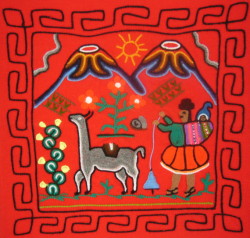
Photo. A beautiful wallhanger from Peru.
The Republic of Peru is a land of contrasts: high mountains, dense jungles, and barren deserts
As the third-largest nation in South America, Perú comprises a population of coastal, Amazonian and Andean inhabitants. In addition to Spanish, Quechua and Aymara, numerous Amazonian languages are also spoken. Its precolonial history includes ancient cultures well before the Incan Empire established its dominance in the 1400s, and many of Perú's instruments can be traced to that time.
In the Andes of Peru weavings are important to every Inca family. Every village has its own weaving patterns and traditions. There are thousands of techniques, layouts, styles, and practices associated with Peruvian weaving. We draw on a tradition of over 2000 years and we are still weaving today.
Handicrafts
Peru is famous for a lot of different, really nice and relatively cheap handicrafts. Keep in mind that buying handicrafts support traditional skills and helps many families to gain their modest income. Look for:
Pullovers, and a lot of other (alpaca-)woolen products in all the Sierra. Puno is maybe the cheapest place.
Wall carpets (tejidos).
Carvings on stone, wood and dried pumpkins.
Silver and gold jewellery.
typical music instruments like pan flutes (zampoñas), skin drums.
many other
For the Aymara and Quechua Indians in the South American Andes, textile art has been the major creative outlet. These descendants of Incan and other Pre-Columbian weavers have concentrated in recent times on intricate warp-patterned structures, producing exquisite fabrics that were both functional and ceremonial. Beginning with traditional motifs, each weaver freely created his or her own variations. Most focused their creative energies on warp-patterned mantles, ponchos, overskirts, belts and bags.
Textile systems developed in Peru over the millennia represent a treasury of techniques rare in the world. Most remain unknown outside of Peru. They are passed on, not by writing, but by the Andean process of person-to-person communication, by watching and practicing.
For the Aymara and Quechua peoples, who live in the highlands of Bolivia and southern Peru and on the shores of Lake Titicaca, textiles have remained the most important form of artistic expression for three thousand years. Cloth is a highly regarded heirloom passed down for generations, connecting people to their ancestors.Additionally, contemporary Andean costume distinguishes gender and regional affiliation.
These woven cloths exhibit astounding technical achievement. Andean women, who are primarily the ones to weave patterned cloth, start by spinning fine yarn using a drop spindle, and use a body tension loom, frame loom, or horizontal staked loom. The magnified images reveal details of the beautiful patterning, but only allow us to imagine the extraordinary complexity that exists within the dense interiors of these ingenious cloth structures.
Peruvian weaving is a ritual activity with many layers of meaning. Peruvian textiles honor Pachamama, Mother Earth. They express appreciation for the process of growth and generation and the concept of relatedness to other species and the natural world.
An essential part of the indigenous Andean mans costume, the coca bag is used to carry coca leaves. The tiny pocket, located at the upper center front, is called uñita, a Quechua term for a nursing baby, animal or human. It holds the lime ash or quinua ash catalyst that is added when the leaves are chewed, in order to ward off fatigue, hunger and altitude sickness. The leaves play a significant role in religious rituals, as offerings to Pacha Mama (Mother Earth).
Most of what has been documented of the country's music revolves around one of the most ancient pre-encounter musical traditions: Andean music. With panpipes, flutes, drums and percussion instruments, many rhythms and dances of the Andes remain today as a testament to their perseverance,
Photo. Machu Picchu's impressive ruins are Peru's foremost tourist attraction. During its 15th and 16th century prime the fortified site was an important stop on the Inca highway. This architectural wonder is especially impressive because it fits so well with the nature.
Stein Morten Lund, 14 August 2006
Additional information
We in Travel Explorations have earlier published several articles and travel tales from Peru. Peruvian cultures and enjoy bustling colourful markets, astonishing wildlife, ancient Inca ruins and friendly locals.
It`s a great adventure to explore the desert city of Lima, spot incredible wildlife in the Amazon Jungle, admire the majestetic condors, discover the mysteries hidden throughout legendary Inca ruins and stay overnight with friendly local folk on Lake Titicaca. Read more about Peru on our website www.TravelExplorations.com
Peru is a country in South America, situated on the western side of that continent, facing the South Pacific Ocean and straddling part of the Andes mountain range that runs the length of South America. Peru is bordered by Ecuador and Colombia to the north, Brazil and Bolivia to the east, and Chile to the south.





 Photo. A beautiful wallhanger from Peru.
Photo. A beautiful wallhanger from Peru.





